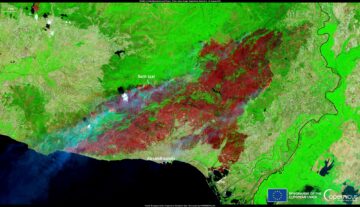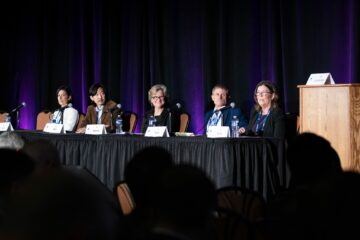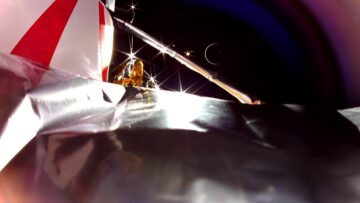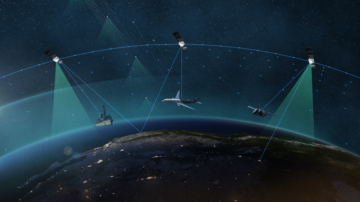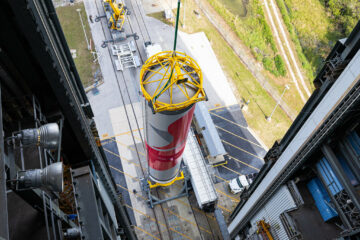Interstate 95 is America’s busiest highway. Spanning over 1,900 miles between Miami in the south and the Canadian border with Maine in the north, it hosts more than 72,000 vehicles on a typical day, and as many as 300,000 in peak traffic, according to the U.S. Department of Transportation. When it was conceived as part of President Dwight D. Eisenhower’s 1956 National Interstate and Defense Highways Act, it was estimated that it would take 10 years to build. Instead, it ended up taking 62, finally crossing the finish line in 2018 with the long-awaited elimination of an 8-mile detour near New Jersey’s border with Pennsylvania.
For motorists on and around I-95, a lot changed in the time it took to complete it. Thanks to GPS, drivers can now navigate with ease, receiving turn-by-turn directions to their final destination. Thanks to smartphones, they can easily look up shopping, restaurants, and rest stops while staying connected to loved ones and colleagues via phone, email and text message. And thanks to high-speed mobile broadband, they can listen on-demand to their favorite songs and podcasts, pull over to join a video call with the office, and download the latest episode of Peppa Pig for their child to watch in the backseat on their tablet.

If you stop to think about it, it’s truly remarkable how far technology has come. What might be even more remarkable than what drivers can do on highways, however, is what they can’t do: Although they can easily use their devices to do the aforementioned things in major metro areas, they often can’t in the disconnected rural areas in between. Nor can they connect universally on airplanes flying 40,000 feet in the sky, or on cruise ships sailing in the middle of the Atlantic Ocean.
What’s irritating to consumers, commuters, and travelers can be devastating for businesses, disaster victims, and warfighters. When your commercial vessel is hijacked by pirates, when an injured loved one is trying to call for help after a hurricane, and when military commanders are trying to warn soldiers about a possible ambush, connectivity isn’t just convenient. It’s essential.
“Every Sunday night I drive from New York City to Washington, D.C. And for a third of that time on I-95 I don’t have connectivity via my cellphone,” lamented Don Claussen, CEO of satellite communications company ST Engineering iDirect, who said satellite networks will soon be able to bridge connectivity gaps not only on I-95, but around the world. “Space-based communications are required if we’re going to connect everything. It all starts there.”
But satellite networks have gaps of their own. If they want to provide truly global connectivity, Claussen said satellite network operators must recognize the importance of ground-based infrastructure and invest in the ingredients that are necessary to bring next-generation ground systems to bear, the most important of which include virtualization, multi-orbit support, open standards, and industry collaboration.
The rebirth of satcom
Humanity’s thirst for connectivity is nothing new. It’s been escalating for decades, according to Claussen, who cited a long line of network technologies that promised ubiquitous connectivity but ultimately failed to deliver it.
“If you look across the last 20 years, in particular, fiber was going to solve all our problems. Everybody was going to have fiber in their house. Then the ‘Gs’ came along. First 2G, then 3G, then 4G, and now 5G. 5G is supposed to fix everything,” Claussen said. “But that’s not going to happen … Everybody has realized that 3G, 4G, and 5G cannot solve all our connectivity issues, and that we’re not going to run fiber to everybody’s home.”
Enter satellite communications, which have become more feasible than ever thanks to the proliferation of affordable launch services and more sophisticated satellites, as well as increased use of new orbital real estate in low Earth orbit (LEO), medium Earth orbit (MEO), highly elliptical orbit (HEO) and continued replenishment of geosynchronous orbit (GEO). “On-orbit capacity is growing, and bandwidth and terminal prices are coming down,” Claussen continued. “As a result, satcom is new again.”

To help satellite communications succeed where other network technologies have failed, the satcom industry must strike while the iron is hot. “Because we’re in a period of disruption, there’s an opportunity to increase the addressable market overall and bring new users in,” Claussen said. “But first, we have to define how we’re going to work together to do that.”
An important first step is identifying and addressing satellite network operators’ biggest needs, the most significant of which is flexibility.
“The network needs to be able to understand patterns and make adjustments on the fly,” Claussen said. “Twenty years ago in the satellite industry, everything was very fixed. Now, everything’s moving around. We’re on airplanes, we’re on ships, and we’re going to be on tractors and in cars. When a plane flies through a beam and then exits it, you might want to move that capacity somewhere else. When the people in a neighborhood wake up and start driving around in their connected cars, you may need to increase satellite capacity there and reduce it somewhere else … Networks need functionality to decide what’s needed and the flexibility to tell a terminal when to switch beams, or a spacecraft when to form them.”
“We’re building a network of networks. And as we bring these networks together, the complexity lies in operations. Simplifying the operations—how our customers move between networks, including the mobility aspects, the bandwidth management, and delivering service-level agreements for customers regardless of where they are or which network they’re connected to—is critical.”
Sridhar Kuppanna, senior vice president of engineering at ST Engineering iDirect
That’s challenging not only from a technical standpoint, but also from a financial standpoint.
“The cost of capacity is service provider’s largest cost component in delivery of their services,” explained Cynthia Harty, senior vice president of corporate development at ST Engineering iDirect. “Service providers are looking for ways to optimize their capacity. They are working with satellite manufacturers as they develop and deploy software-defined satellites that will facilitate flexibility for the network operator that never existed before—the ability to spin up new beams, resize beams, and deal with congestion issues more dynamically than they have been able to do in the past.”
Flexibility demands more and better integration between satellite network operators and ground segment providers. “Our network management system tells the service provider everything they need to know about their iDirect network. We host a wealth of data within the NMS about the ground infrastructure in regards to congestion within beams and compliance with quality of service profiles. And as software-defined satellites come online, we need to orchestrate those resources as well so the operator can take full advantage of those satellites’ capabilities,” Harty continued. “What network operators and service providers want and need is tighter integration to optimize that very expensive component of their delivery value chain.”
Cost isn’t the only challenge for network operators, another is differentiation, a key component of which is the user experience. “The service orchestration from the ground segment to the remote device is all about ‘zero touch.’ Network operators and service providers want the ability to establish new service plans and new offerings; to create them, deploy them, and commission new users without having to increase operational support as their network scales,” Harty said. “That allows them to deliver the best user experience possible while still meeting their financial objectives.”
Exploiting virtualization and multi-orbit support
In March, ST Engineering iDirect unveiled its next-generation ground system to help satellite network operators overcome their biggest challenges and seize their biggest opportunities. Called Intuition, it sets benchmarks for future ground systems that will help the satcom industry deliver the global connectivity end users demand from it.
Intuition is oriented around five capabilities, in particular: virtualization to support fast, cost-effective scaling of services; multi-orbit support to deliver services for a variety of satcom applications, regardless of orbit; standards-based network convergence to integrate satellite networks seamlessly into the global communications domain; end-to-end orchestration to dynamically adjust resource and service allocation in response to variable demand; and flexible go-to-market strategies to reach more customers with the widest possible range of business models.
Intuition introduces a fundamental change to deploying satellite networks
Although all five capabilities are critical, virtualization stands out as especially vital, according to Harty, who said the hypercompetitive satcom landscape of today demands maximum speed to market and minimum time to revenue. “Historically, a service provider that wanted to enter a new market had to order infrastructure, which meant going through a procurement process that included placing a purchase order, shipping the hardware, installing it, testing it, and then finally bringing it into production. That could be a several months long cycle,” she said. “By virtualizing our platform, our vision is for that to take a mere fraction of that time. Will it be shortened to minutes or hours tomorrow? No. But what we’re doing is we’re helping service providers make business decisions and deploy those decisions as quickly as possible by utilizing the technological advancements that are taking place in the cloud. We will be able to cut that time-to-revenue window for them simply by alleviating the physical hardware issues that they’ve experienced in the past.”
Speed goes hand-in-hand with scalability, added Sridhar Kuppanna, senior vice president of engineering at ST Engineering iDirect. “Why do we need to go to virtualization in the cloud?” he asked. “Because if you want to dynamically scale, then you cannot rely on racking and stacking new hardware every time you try to increase capacity. You need cloudification in order to scale up and scale down based on demand.”
Along with its virtualized, cloud-based infrastructure, Intuition’s emphasis on multi-orbit support is a powerful indicator of how ground systems need to evolve to support current and future connectivity needs.

“No single orbit is best to service the entire market … so bringing all orbits together and allowing users to seamlessly roam between them is really important,” explained Claussen, who said multiple orbits are needed not only because of advantages and disadvantages of each, but also because of limited coverage. “Think about military use cases like en route mission planning. You want to be connected all the way from where you start to where you’re going to end, and in that circumstance there’s not a single orbit that can meet all the user’s needs.”
It’s not just military users, either. It’s also everyday consumers, according to Kuppanna, who stressed the myriad applications that might run on satcom networks. “Look at the broadband use cases that users are consuming today,” he said. “Previously, it was internet data traffic—browsing websites or using social media. Now it’s voice and video communications and may soon be things like connected cars and so forth. Each of these applications has variable latency, reliability, scalability, and capacity requirements. If you want to make a Microsoft Teams call, using LEO capacity makes sense. Hence, you need to be able to move between orbits to service the right application at the right time.”
Open standards and industry collaboration are key
If there were just one word to define next-generation ground systems, it would probably be “interoperability,” the heart of which is open standards.
“It’s standards that will allow us to interoperate in a more cost-effective manner, which is what’s important for service providers and operators,” explained Harty, who cited as examples several industry standards that ST Engineering iDirect is currently helping to develop. One is the Digital Intermediate Frequency Interoperability (DIFI) Consortium, whose work is focused on developing a digital intermediate frequency/radio frequency (IF/RF) standard that will accelerate the transition from hardware-based systems to software-defined networks.
“Historically, companies in our industry have been vendor-locked. You get terminals and hub infrastructure all from the same vendor, and if you have to move from one terminal vendor to another, you have to replace your entire network,” Kuppanna said. “As networks are evolving and new technology is coming onto satellites, most customers are going to expect a multi-vendor solution … In telco, you can switch from AT&T to Verizon on the fly, and satcom users are going to have the same expectations of satellite networks.”
In addition to ending vendor lock-in, interoperability will enable ubiquitous connectivity by allowing users to migrate not just between vendors, but also between terrestrial and satcom networks. In pursuit of the latter, the 3rd Generation Partnership Project (3GPP) is creating a mobile broadband standard that will allow terrestrial communication service providers to cooperate with satellite network operators to establish connectivity between terrestrial systems and satellite systems.
“It’s critical that 5G releases and eventually 6G releases accommodate satcom natively,” Harty said. “When it’s an inherent requirement from the beginning, it will help all of us be able to deliver on true seamless roaming between terrestrial and satcom.”
ST Engineering iDirect believes so strongly in interoperability that is has designed its Intuition ground system in a way that will drive open standards like DIFI and 3GPP into the market. “When you start talking about something new, there’s always inertia and hesitation,” Claussen said. “But when you start doing demonstrations—which we’re doing and will continue to do—people begin to realize the benefits. So, we’re absolutely going to drive standards into our products, and we’re going to continue participating in standards bodies to make sure we get to a point where satcom is not an afterthought, but a forethought.”
Because it recognizes that it can’t change the industry by its lonesome, ST Engineering iDirect embraces collaboration with peers, competitors, and customers.
“We’ve historically been an innovator in the industry and often promote and work with other members of our ecosystem to do various proofs of concept,” Harty said. “The burden is on us as a participant in the industry to do these proofs of concept to help raise awareness and education not only in the industry, but specifically among our customers. All the innovation currently coming to market can be unsettling. Completing these proofs of concept with our partners and customers helps ease anxiety about innovation and proves that it can be done. By doing that work, and doing collaboratively with partners and customers, it makes it easier to adopt new technology.”
‘Not the same old satcom game’
The combined power of virtualization, multi-orbit support, open standards, and industry collaboration is awesome. And yet, there’s at least one major obstacle that could still stunt satcom’s growth: operational complexity.
“We’re building a network of networks. And as we bring these networks together, the complexity lies in operations,” Kuppanna said. “Simplifying the operations—how our customers move between networks, including the mobility aspects, the bandwidth management, and delivering service-level agreements for customers regardless of where they are or which network they’re connected to—is critical.”
Ground systems that use artificial intelligence and machine learning to analyze, predict, and orchestrate network traffic are key. “At the scales that are going to be required, controlling inputs and outputs can’t be done by a single person or group of people,” Claussen said. “You need networks that are self-aware.”
Hence the name Intuition. “It wasn’t an accident that we picked the name Intuition for our next-generation product, because it sends a message to industry that intuition is what’s needed,” Claussen continued. “Efficiency is always going to be important, but it’s no longer about who has the most efficient waveform or the smallest modem. It’s about who can bring all these disparate networks together and make it seamless.”
Whoever does that will be a hero to drivers on interstates, passengers on planes, sailors at sea, soldiers at war, and countless others who need continuous connectivity but currently lack it.
“We’ve pivoted really hard to address market needs,” Claussen concluded. “Because it’s not the same old satcom game anymore.”
- SEO Powered Content & PR Distribution. Get Amplified Today.
- PlatoData.Network Vertical Generative Ai. Empower Yourself. Access Here.
- PlatoAiStream. Web3 Intelligence. Knowledge Amplified. Access Here.
- PlatoESG. Carbon, CleanTech, Energy, Environment, Solar, Waste Management. Access Here.
- PlatoHealth. Biotech and Clinical Trials Intelligence. Access Here.
- Source: https://spacenews.com/the-satellite-industry-will-answer-the-demand-for-telco-interoperability-with-next-generation-ground-infrastructure/
- :has
- :is
- :not
- :where
- $UP
- 000
- 1
- 10
- 20
- 20 years
- 2018
- 2024
- 24
- 29
- 300
- 3rd
- 3rd generation
- 40
- 5G
- 62
- 6G
- 72
- 900
- a
- ability
- Able
- About
- about IT
- absolutely
- accelerate
- accident
- accommodate
- According
- across
- Act
- added
- addition
- address
- addressable
- addressing
- adjust
- adjustments
- adopt
- advancements
- ADvantage
- advantages
- affordable
- After
- again
- ago
- agreements
- Airplanes
- All
- allocation
- allow
- Allowing
- allows
- along
- also
- Although
- always
- am
- among
- an
- analyze
- and
- and infrastructure
- Another
- Anxiety
- anymore
- Application
- applications
- ARE
- areas
- around
- artificial
- artificial intelligence
- Artificial Intelligence and Machine Learning
- AS
- asked
- aspects
- At
- AT&T
- awareness
- awesome
- Bandwidth
- based
- BE
- Beam
- Bear
- because
- become
- been
- begin
- Beginning
- believes
- benchmarks
- benefits
- BEST
- Better
- between
- Biggest
- bodies
- border
- BRIDGE
- bring
- Bringing
- broadband
- build
- Building
- burden
- busiest
- business
- business models
- businesses
- but
- by
- call
- called
- came
- CAN
- Canadian
- cannot
- capabilities
- Capacity
- cars
- cases
- ceo
- chain
- challenge
- challenges
- challenging
- change
- changed
- child
- circumstance
- cited
- City
- Cloud
- collaboration
- colleagues
- combined
- come
- coming
- commercial
- commission
- Communication
- Communications
- commuters
- Companies
- company
- Company’s
- competitors
- complete
- completing
- complexity
- compliance
- component
- conceived
- concept
- concluded
- congestion
- Connect
- connected
- Connectivity
- consortium
- Consumers
- consuming
- content
- continue
- continued
- continuous
- controlling
- Convenient
- Convergence
- COOPERATE
- Corporate
- Cost
- cost-effective
- could
- countless
- coverage
- create
- Creating
- critical
- crossing
- cruise
- Current
- Currently
- Customers
- Cut
- cycle
- D.C.
- data
- day
- deal
- decades
- decide
- decisions
- Defense
- define
- Degree
- deliver
- delivering
- delivery
- Demand
- demands
- Department
- department of transportation
- deploy
- deployed
- deploying
- designed
- destination
- devastating
- develop
- developing
- Development
- device
- Devices
- differentiation
- digital
- directions
- disaster
- disconnected
- disparate
- Disruption
- do
- does
- doing
- domain
- don
- done
- Dont
- down
- download
- drive
- drivers
- driving
- dynamically
- each
- earth
- ease
- easier
- easily
- ecosystem
- Education
- efficient
- either
- else
- embedded
- Embraces
- emphasis
- enable
- end
- end-to-end
- ended
- ending
- Engineering
- Enter
- Entire
- environments
- episode
- escalating
- especially
- essential
- establish
- estate
- estimated
- Even
- eventually
- EVER
- Every
- everybody
- everyday
- everything
- evolve
- evolving
- examples
- existed
- exits
- expect
- expectations
- expensive
- experience
- experienced
- explained
- facilitate
- Failed
- far
- FAST
- Favorite
- feasible
- Feet
- final
- Finally
- financial
- finish
- First
- five
- Fix
- fixed
- Flexibility
- flexible
- flying
- focused
- For
- forethought
- form
- forth
- fraction
- Frequency
- from
- full
- functionality
- fundamental
- fundamentally
- future
- game
- gaps
- generation
- get
- Global
- Go
- Go-To-Market
- Goes
- going
- gps
- greatest
- Ground
- Group
- Growing
- Growth
- had
- happen
- Hard
- Hardware
- Have
- having
- he
- Heart
- help
- helping
- helps
- hence
- Hero
- High
- highly
- Highway
- highways
- historically
- Home
- host
- hosts
- HOT
- HOURS
- House
- How
- However
- HTTPS
- Hub
- hurricane
- i
- identifying
- if
- importance
- important
- in
- include
- included
- Including
- Increase
- increased
- Indicator
- industry
- industry standards
- inertia
- Infrastructure
- ingredients
- inherent
- Innovation
- Innovator
- inputs
- installing
- instead
- integrate
- integration
- Intelligence
- Intermediate
- Internet
- Interoperability
- interoperate
- into
- Introduces
- intuition
- Invest
- issues
- IT
- ITS
- join
- jpg
- just
- just one
- Key
- Know
- Lack
- landscape
- largest
- Last
- Latency
- latest
- latter
- launch
- learning
- least
- LEO
- lies
- like
- Limited
- Line
- listen
- Long
- long-awaited
- longer
- Look
- looking
- Lot
- loved
- Low
- machine
- machine learning
- Maine
- major
- make
- MAKES
- management
- management system
- manner
- Manufacturers
- many
- March
- Market
- max-width
- maximum
- May..
- meant
- Media
- medium
- Meet
- meeting
- Members
- mere
- message
- Metro
- Miami
- Microsoft
- microsoft teams
- Middle
- might
- migrate
- Military
- minimum
- minutes
- Mission
- Mobile
- mobility
- models
- months
- more
- most
- move
- moving
- multiple
- must
- my
- myriad
- name
- National
- natively
- Navigate
- Near
- necessary
- Need
- needed
- needs
- network
- network traffic
- networks
- never
- New
- new hardware
- New Market
- new users
- New York
- new york city
- next
- next-generation
- night
- no
- nor
- North
- nothing
- now
- objectives
- obstacle
- ocean
- of
- Offerings
- Office
- often
- Old
- on
- On-Demand
- ONE
- ones
- online
- only
- onto
- open
- operational
- Operations
- operator
- operators
- opportunities
- Opportunity
- Optimize
- or
- Orbit
- orchestration
- order
- Other
- Others
- our
- out
- outputs
- over
- overall
- Overcome
- own
- part
- participant
- participating
- particular
- partners
- Partnership
- past
- patterns
- Peak
- peers
- Pennsylvania
- People
- period
- person
- phone
- physical
- picked
- Pirates
- Place
- placing
- plane
- Planes
- planning
- plans
- platform
- plato
- Plato Data Intelligence
- PlatoData
- Podcasts
- Point
- possible
- power
- powerful
- predict
- president
- Prices
- probably
- problems
- process
- procurement
- Product
- Production
- Products
- Profiles
- project
- proliferation
- promised
- promote
- proofs
- proves
- provide
- provider
- providers
- provides
- purchase
- purchase order
- pursuit
- quality
- quickly
- raise
- range
- reach
- real
- real estate
- realize
- realized
- really
- receiving
- recognize
- recognizes
- reduce
- Regardless
- regards
- Releases
- reliability
- rely
- remarkable
- remote
- replace
- required
- requirement
- Requirements
- resource
- Resources
- response
- REST
- Restaurants
- result
- revenue
- right
- Route
- Run
- Rural
- Rural Areas
- s
- Said
- sailing
- same
- satellite
- satellites
- Scalability
- Scale
- scales
- scaling
- SEA
- seamless
- seamlessly
- segment
- Seize
- sends
- senior
- sense
- service
- Service Provider
- service providers
- Services
- Sets
- several
- she
- Shipping
- ships
- Shopping
- shortened
- significant
- simplifying
- simply
- single
- sky
- smallest
- smartphones
- So
- Social
- social media
- solution
- SOLVE
- something
- somewhere
- songs
- Soon
- sophisticated
- South
- Space
- spacecraft
- spanning
- specifically
- speed
- Spin
- st
- stacking
- standard
- standards
- standpoint
- stands
- start
- starts
- staying
- Step
- Still
- Stop
- Stops
- strategies
- strike
- strongly
- succeed
- sunday
- support
- supposed
- sure
- Switch
- system
- Systems
- T
- Tablet
- Take
- taking
- talking
- teams
- Technical
- technological
- Technologies
- Technology
- Telco
- tell
- tells
- Terminal
- terminals
- terrestrial
- Testing
- text
- than
- thanks
- that
- The
- the world
- their
- Them
- then
- There.
- These
- they
- things
- Think
- Third
- those
- Through
- tighter
- time
- to
- today
- together
- tomorrow
- took
- touch
- traffic
- transition
- transportation
- travelers
- true
- truly
- try
- trying
- typical
- u.s.
- ubiquitous
- Ultimately
- understand
- universally
- unveiled
- Unveils
- us
- use
- User
- User Experience
- users
- using
- Utilizing
- value
- variable
- variety
- various
- Vehicles
- vendor
- vendors
- Verizon
- very
- Vessel
- via
- vice
- Vice President
- victims
- Video
- vision
- vital
- Voice
- Wake
- Wake Up
- want
- wanted
- war
- was
- washington
- Watch
- Way..
- ways
- we
- Wealth
- websites
- WELL
- were
- What
- when
- which
- while
- WHO
- whose
- widest
- will
- window
- with
- within
- without
- Word
- Work
- work together
- working
- world
- would
- years
- yet
- york
- you
- Your
- youtube
- zephyrnet


